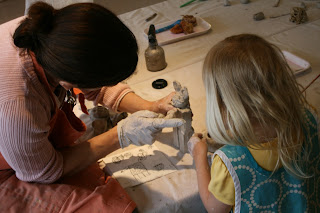Most days in the studio are very busy. I can often be found at the head of a long line of children, each eager to share a story, or to have something attached with hot glue, or to procure a newly threaded needle, or to plan their latest creative endeavor. Today was no different. As I worked and listened and assisted, I glanced around the room and noticed a fair haired boy seated at a remote table. He colored and glued in peaceful solitude. Satisfied, I returned to the line of eager children.
At the end of the day, I glanced up to see the fair haired child waiting patiently and proudly to share his art with me. I approached him and he handed his piece of art up to me with a gesture of confidence.
I responded too quickly and without reflection. I responded with the unquestioned bias of a "grown up". I looked at his collage and the crisp dollar bill glued to the front. I inwardly gasped. I calmly explained why we couldn't use money on our art pieces and carefully began to remove the dollar bill. His eyes welled up with tears and I stopped myself.
I took a deep breath.
I crouched low and with great care, I apologized.
I explained that I was worried that I might get into trouble for allowing a child to use money in this way but I wanted to understand his art.
His face cleared and he slowly explained how he had made this picture for the art show.
I smiled and asked him if he would tell me more about the dollar he had used and he said:
At the end of the day, I glanced up to see the fair haired child waiting patiently and proudly to share his art with me. I approached him and he handed his piece of art up to me with a gesture of confidence.
I responded too quickly and without reflection. I responded with the unquestioned bias of a "grown up". I looked at his collage and the crisp dollar bill glued to the front. I inwardly gasped. I calmly explained why we couldn't use money on our art pieces and carefully began to remove the dollar bill. His eyes welled up with tears and I stopped myself.
I took a deep breath.
I crouched low and with great care, I apologized.
I explained that I was worried that I might get into trouble for allowing a child to use money in this way but I wanted to understand his art.
His face cleared and he slowly explained how he had made this picture for the art show.
I smiled and asked him if he would tell me more about the dollar he had used and he said:
"A dollar is something that you earn for doing something.
It's made out of paper, but it's just paper.
I use paper to make art.
I got this dollar from a person.
They gave it to me, just because,
and now it's a picture."
I told him that I would be proud to hang it in the art show and he smiled broadly at me before returning to his class.
I stared after him, amazed and humbled by the beauty and wisdom of children.
A dollar IS paper after all and it is hardly worth the price of a child's belief in himself as an artist with a right to express and be heard.











